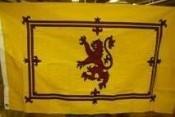William, who succeeded his father, Malcolm IV in 1165, was known as William the Lion. Our first positive evidence that the lion rampant had become “the Arms of Dominion of Scotland” was in 1222, when it appeared in the seal of his son, Alexander II. Before this time, the Scottish royal standard bore a dragon. We know of legendary use of the lion rampant by Fergus I in 300 BC.
FLAG QUALITY AND USES
Premium Quality
Construction: Cotton Authentic
– Beautiful, full textured and striking
– Cotton weave looks, feels and moves properly
– Designs are embroidered
– Attaches easily to any flag pole
Note on the reverse (backs) of flags: It is standard traditional flag construction that images, words and other adornments on a flag are “backwards” when viewed from behind. It is not correct to sew two standard flags back-to-back in order for them to read the same from both directions.
RECOMENDED USES:
– Re-enactment, historical drama
– Indoor displays, Museums
– Honor Guards, Color guards*
– Caskets, Memorials, Funerals
– Official Uses, diplomatic display
(NOTE: Not for outdoor or wet use. *May be too heavy for long term marching use. See Nylon flags for lighter alternatives.)
Additional information
| Weight | 2 oz |
|---|





Reviews
There are no reviews yet.